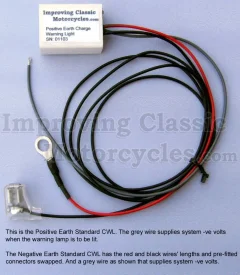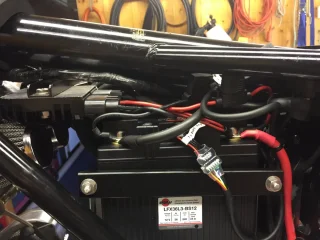Thanks for visiting Access Norton
- Guest view limit reached
- Create a free account (more details)
- Already a member? Click here to login
You are using an out of date browser. It may not display this or other websites correctly.
You should upgrade or use an alternative browser.
You should upgrade or use an alternative browser.
Biting the bullet on charging system
- Thread starter Ted Lang
- Start date
- Status
- Not open for further replies.
http://sparkbright.co.uk/sparkbright-eclipse-battery-voltage-monitor.php
These fit right into the charge indicator hole on the MK3 or small indicator light holes in the headlight shell with other bikes. If those are in use, it's easy to drill an extra hole for the Sparkbright.
This gives a much better idea of what's happening with the charging system than a bouncy ammeter needle does. The Sparkbright runs in parallel to the system on two little wires, tie into a low draw hot wire anywhere in the system ( not headlight) Waterproof &Night time auto dimming.
Glen
These fit right into the charge indicator hole on the MK3 or small indicator light holes in the headlight shell with other bikes. If those are in use, it's easy to drill an extra hole for the Sparkbright.
This gives a much better idea of what's happening with the charging system than a bouncy ammeter needle does. The Sparkbright runs in parallel to the system on two little wires, tie into a low draw hot wire anywhere in the system ( not headlight) Waterproof &Night time auto dimming.
Glen
@worntorn or you can use one of these:

https://www.improvingclassicmotorcycles.com/products.htm
The ‘Standard Charge Warning light’ allows you to use the original lamp so that it matches the others on your headlight!
We fitted one to the MK3 and it works a treat.
They also do a ‘Deluxe’ version with an LED that fits into pre MK3 lens bezels.

https://www.improvingclassicmotorcycles.com/products.htm
The ‘Standard Charge Warning light’ allows you to use the original lamp so that it matches the others on your headlight!
We fitted one to the MK3 and it works a treat.
They also do a ‘Deluxe’ version with an LED that fits into pre MK3 lens bezels.
Looks neat, but I would still recommend the Eclipse as it's a voltmeter + charge warning light rather than a straight charge warning light.
You really get a good understanding of whats happening with the electrical system while under various loads and still have the idiot light effect, which I seem to need.
On edit-Reading the full ad I see the lower unit, the " Tricolour" , is very similar to the Eclipse, maybe not quite as fine on range.
Eclipse voltage monitor in the MK3 console- ( the red light)
In a headlight shell. Use an existing hole or drill a new hole, 3/8" for this version.
You really get a good understanding of whats happening with the electrical system while under various loads and still have the idiot light effect, which I seem to need.
On edit-Reading the full ad I see the lower unit, the " Tricolour" , is very similar to the Eclipse, maybe not quite as fine on range.
Eclipse voltage monitor in the MK3 console- ( the red light)
In a headlight shell. Use an existing hole or drill a new hole, 3/8" for this version.
Last edited:
Tornado
VIP MEMBER
- Joined
- Dec 5, 2017
- Messages
- 5,257
Yes, the size of these units was one reason I have gone with the Tympanium. Got it mounted yesterday in the stock rec location. Made up a 1/4" alu mounting plate so it can sit clear of the frame web while using one of the mudguard bracket bolts and the 2 MC mounting bolt. Now I just need a fresh uncooked battery.So, I just received the FH020AA from an eBay vendor. This thing is big, I dunno where I'm gonna put it. The fuse they supplied is like 2 inches square - I've never seen a blade fuse holder that big before. Looks like 12 or 10 gauge wires, fused at 30 amps. Holy cow. Definitely heavy duty. Will install tomorrow.
- Joined
- Jan 2, 2013
- Messages
- 4,255
Fast Eddie
VIP MEMBER
- Joined
- Oct 4, 2013
- Messages
- 22,682
And another mounting idea. Note I also dispensed with the trip unit thingy and used a blade fuse instead...

Tornado
VIP MEMBER
- Joined
- Dec 5, 2017
- Messages
- 5,257
My understanding is they both use the same single phase diode arrangement for rectifying. Both are shunt type regulators which, though not as technically superior as the sh775 type, are standard fitment in nearly all modern bikes and have long history of good performance. Main difference between pod and Tympanium is no cooling fins on the Tympanium. Mine is 200W rating. Pods can be had in different ratings with or without built in capacitor and either single or three phase. My capacitor is working fine so didn't need the added cost.To anyone that knows; Are the Podtronics and Tympanium essentially the same?
Here is my installation:
- Joined
- Feb 10, 2009
- Messages
- 3,166
not as technically superior as the sh775 type,
Or they might be.
robs ss
VIP MEMBER
- Joined
- Aug 16, 2016
- Messages
- 4,231
TedRob-- I don't know about that specific model, but it should be easy to find out.
I have emailed Pazon and asked them if it is shunt or series.
I'll post their response here
Cheers
Rob
@maylar the big square thing is a thermal trip - I tend to use a standard blade fuse instead.
A couple of mounting options for you:
View attachment 12489
View attachment 12490
Better to have plugs on the bottom so they are not drinking water.
@JimC agreed - it would have been better to have the connectors on the bottom.
But the convenience of not having to stand on your head to take the connectors on and off made the decision.
But the convenience of not having to stand on your head to take the connectors on and off made the decision.
- It’s well protected from the elements in there.
- The connectors are waterproof.
- The battery and the spark plugs still seem to work, and they are the same way up.
acadian
VIP MEMBER
- Joined
- Mar 5, 2010
- Messages
- 1,477
Isn’t the current being shunted by the regulator when you have LED lights the same current that would have been going through the incandescent lights?
So the stator isn’t “suffering” any more than before?
A shunt regulator acts as a low resistance path to ground and this ensures that the stator will have the maximum current flowing in it that is a function of engine rpm. Higher rpm = higher watts. As rpm's increase, so too does the current and heat in the stator. Since stators fail by burning the insulation, anything we can do to lower the heat in the stator will help reduce the likelihood of failure. This is where the shindengen style series regulator is advantageous.
Last edited:
- Joined
- Jan 31, 2010
- Messages
- 3,201
@worntorn or you can use one of these:
View attachment 12491
https://www.improvingclassicmotorcycles.com/products.htm
The ‘Standard Charge Warning light’ allows you to use the original lamp so that it matches the others on your headlight!
We fitted one to the MK3 and it works a treat.
They also do a ‘Deluxe’ version with an LED that fits into pre MK3 lens bezels.
I watched the video and I don't see what their standard charge warning light does that is any different than the OEM charge light. ???
@MexicoMike
It tells you four things:
Most importantly though, the assimilator according to Boyer Bransden ‘must be removed’ when you fit one of their Power Box Regulator/Rectifiers as they are ‘not compatible’
I wonder if they are also not compatible with Podtronics or Tympaniums too on the grounds that they use the same components?
It tells you four things:
- That the alternator is working
- That it is generating sufficient power to cope with demand and keep the battery charged
- They also warn of overcharging
- Warns of a flat battery when ignition is switched on
Most importantly though, the assimilator according to Boyer Bransden ‘must be removed’ when you fit one of their Power Box Regulator/Rectifiers as they are ‘not compatible’
I wonder if they are also not compatible with Podtronics or Tympaniums too on the grounds that they use the same components?
- Joined
- Feb 10, 2009
- Messages
- 3,166
A shunt regulator acts as a low resistance path to ground and this ensures that the stator will have the maximum current flowing in it that is a function of engine rpm. Higher rpm = higher watts. As rpm's increase, so too does the current and heat in the stator. Since stators fail by burning the insulation, anything we can do to lower the heat in the stator will help reduce the likelihood of failure. This is where the MOSFET style series regulator is advantageous.
Most MOSFET regulators for permanent magnet alternators appear to be shunt type.
Having now read more on the subject here and there on the wwweb, I’m no expert, but I feel equipped to ignore the advice to use series regulation.
- Status
- Not open for further replies.
Similar threads
- Replies
- 7
- Views
- 2,522
- Replies
- 47
- Views
- 8,470



